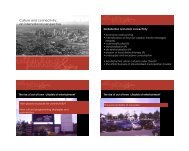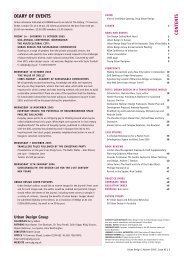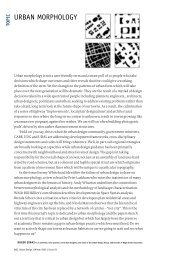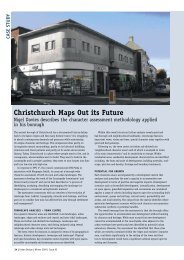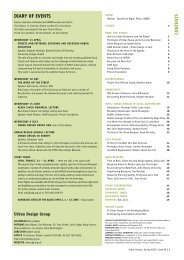topic - urban-design-group.org.uk
topic - urban-design-group.org.uk
topic - urban-design-group.org.uk
You also want an ePaper? Increase the reach of your titles
YUMPU automatically turns print PDFs into web optimized ePapers that Google loves.
TOPIC<br />
NEWCASTLE GATESHEAD PATHFINDER<br />
Michael Crilly outlines ongoing initiatives on Tyneside<br />
The test will be if the<br />
measures of success<br />
of the programme are<br />
qualitative, not<br />
simply empirically<br />
driven outputs<br />
Above Vernon Gracie, project architect on the<br />
redevelopment of the Byker estate 1969-1982,<br />
providing a guided tour of contemporary housing<br />
schemes in Stockholm (Bo02 Housing Expo,<br />
Hammarby Sjöstad, and Järla Sjö, Nacka) for a <strong>group</strong><br />
of current Byker residents and ward councillors.<br />
Opposite page Walker Riverside is an ODPM pilot area<br />
for <strong>design</strong> coding. Diagram shows the aspects of the<br />
public and private realm to be coded.<br />
The establishment of a pathfinder<br />
programme in Newcastle and Gateshead<br />
can be misleading for those who don’t<br />
understand some of the peculiarities and<br />
complexities of the housing market in<br />
the north east of England. The core of the<br />
Tyneside conurbation, in common with<br />
most of the ‘core cities’, is a successful<br />
and growing housing market. Both<br />
municipalities have benefited from the<br />
attractions of the historic neo-classical<br />
city centre centred on Grainger Town and<br />
the qualities of ‘bluefield’ development<br />
sites on Newcastle’s East Quayside and<br />
south of the river at Gateshead’s Baltic<br />
Quays. This <strong>urban</strong> core is encircled by<br />
high value, middle class, liberal voting<br />
areas packed full of well maintained,<br />
high quality, high density Edwardian<br />
terraces and populated by established<br />
communities, families and graduates<br />
working in the growing sectors of the<br />
creative industries.<br />
Yet, similar housing in some areas to<br />
the west, east and south of the city centre<br />
have very different social characteristics<br />
that demonstrate the underlying features<br />
of the pathfinder area on Tyneside and<br />
the historical associations with working<br />
class housing. The geographical core<br />
of the pathfinder is centred along the<br />
riverside in areas close to the city centre<br />
that have traditionally been dominated<br />
by heavy industry and now contain<br />
large areas of homogenous low-cost and<br />
social housing. The private housing<br />
market in the area has been influenced<br />
by the stigma attached to the area, and<br />
particularly to the housing tenure, as<br />
much as the physical characteristics of<br />
the location or the housing types. Yet<br />
in contrast, the north east of England as<br />
a region is stabilising and, dependent<br />
upon the statistical evidence you refer<br />
to, actually growing in population and<br />
housing demand. In this context, there<br />
are growth areas and ‘hotspots’ in many<br />
of the peripheral market towns and<br />
suburbs.<br />
It is this regional <strong>urban</strong> context, one<br />
where the attraction of residential areas is<br />
heavily dependent upon socio-economic<br />
factors and typically complex and<br />
unpredictable, where the discipline of<br />
<strong>urban</strong> <strong>design</strong> is becoming one of the key<br />
regeneration professions.<br />
In an area where the underlying<br />
social factors and perceptions of the<br />
area are the primary causes of housing<br />
market decline, the challenge is to adopt<br />
a <strong>design</strong>-led approach to addressing<br />
location and tenure based stigma. As<br />
such, the Newcastle Gateshead pathfinder<br />
is not simply a physical programme of<br />
regeneration but one that has to be based<br />
on the identification and promotion of<br />
new housing markets. It is this thematic<br />
area of work where <strong>urban</strong> planning and<br />
<strong>design</strong> has begun exploring different<br />
approaches to identifying, testing and<br />
promoting new housing choices. Often<br />
these areas are deliberately not trying<br />
to compete with sub<strong>urban</strong> forms of<br />
development but to establish or reevaluate<br />
complementary forms of <strong>urban</strong><br />
development that help to restructure the<br />
social and tenure mix within many of<br />
the existing inner city communities and<br />
avoid potential residential displacement<br />
within the conurbation.<br />
The overall scale of change anticipated<br />
on Tyneside within the four different area<br />
frameworks is ambitious. While there<br />
are inevitable variations in emphasis<br />
between areas, the approach and value<br />
of <strong>urban</strong> <strong>design</strong> is gradually becoming<br />
evident through a variety of different<br />
projects. These are unfashionable in<br />
focusing upon different <strong>design</strong> and<br />
procurement processes, highlighting<br />
26 | Urban Design | Autumn 2004 | Issue 92



